关键词 > Physics
Physics: Dynamics and Torques
发布时间:2024-05-11
Hello, dear friend, you can consult us at any time if you have any questions, add WeChat: daixieit
Physics: Dynamics and Torques
|
Inquiry Question |
|
As the movie-going audience becomes more and more “scientifically sophisticated”, the demand for physics-minded consultants has risen dramatically over the past decade. They help create realistic special effects that often blur the line between reality and entertainment. The movie “ Commando” was filmed in the 80s… |

Arnold Schwarzenegger has been a Hollywood icon for decades. His name has become synonymous with "Action Hero" and raw strength. But Hollywood can push it …
The picture above is from the 1985 movie Commando where Arnold plays retired United States Special Forces Colonel John Matrix. The scene depicts Colonel John Matrix disposing of one of the "bad guys" (Sully) by dropping him from a cliff. Only Arnold is capable of lifting a grown man by the ankle with one fully extended arm.
…or is he? Let's examine the physics that would enable Arnold to perform this feat.
|
Instructions |
|
Using a pencil, answer the following questions. The lab is marked based on clarity of responses, completeness, neatness, and accuracy. Do your best! Please ensure that any data measured (or recorded) includes the appropriate number of significant digits (only one uncertain digit). |
|
This activity is divided into three sections: • Core – this first section explores only the basic “core” ideas involved in understanding. Students must demonstrate a sound understand with all of their answers in this section BEFORE attempting the next section. • Mastery – Your instructor will NOT review this section if the Core section above shows any misconceptions. In this section students will make predictions and apply the concepts and ideas learned above. For complete mastery it is expected that data collection and scientific procedures will be as accurate as possible. All work shown should be clear with any units included. Answers should be rounded off to the correct number of significant figures based on the data collected. • Ace – Once again, your instructor will only look at this section provided he/she is confident that the above Mastery criteria has been met. In this section students will demonstrate a deeper understanding of the concepts through error analysis, experimental design etc. Physics concepts from other units already covered will often be required here. |
Learning Objectives:
1. Describe the ideal position that might enable Arnold to perform this feat of strength more effectively.
2. Discuss how the center of mass location can affect the torque it creates
3. Determine, mathematically, where Arnold's center of mass should be for this video
4. Given the actual location of Arnold's center of mass, determine, mathematically, what Arnold's mass would need to be to pull this "dangle" off
Part 1: Core
Watch the video clip below to get a feel for what is happening.
Hmmm …
1. Label the Center of Mass (COM) for each of the following uniform objects.
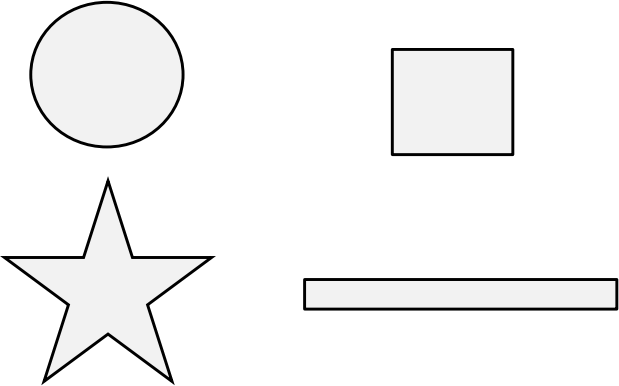
2. The planks shown below are all of the same mass and length. They are positioned on top of a wedge so that they are free to rotate. Rank the images below from largest to smallest torque generated by the plank's center of mass. Assume the largest is the one with the most "clockwise" torque, while the smallest is the most counter-clockwise.
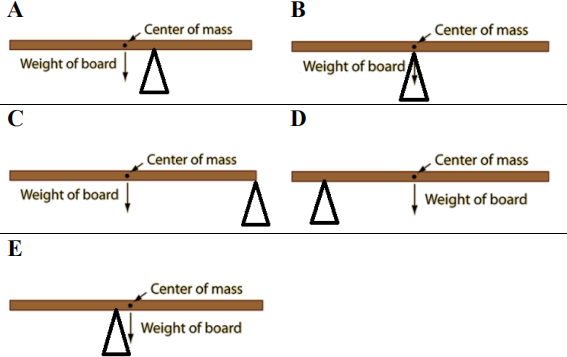
Largest Torque Smallest Torque
Explain how you arrived at this ranking (include references to any appropriate physics equations)
_____________________________________________________________________________________
|
3. In general, where is the center of mass located on the human body? |
|
4. Perform the following task. Stand so that you are facing a wall. Position your feet so that your toes are touching the wall where it meets the floor. While maintaining this position try to go up on your toes ("tip- toe" style). Describe what happens. Discuss rotation. |
5. Repeat the above procedure away from the wall and (hopefully) success is achieved. What changed? Pay
attention to how your body moves.
_____________________________________________________________________________________
_____________________________________________________________________________________
6. Locate the center of mass, COM, on the bodies below then label all of the forces acting on the body in
these two positions. Note: the force of gravity will be directed straight down and is located at the center of mass.
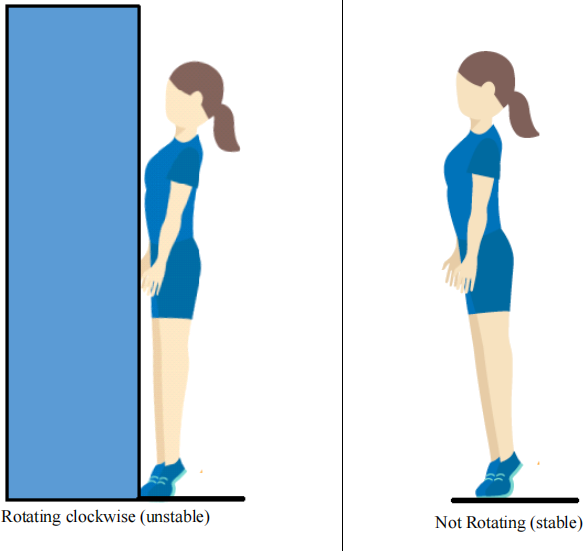
Torque, τ, is a "rotational" quantity defined by a simple equation τ = Fxd, where both F and d must be perpendicular to each other. Sometimes it is advantageous to find the force component that is
perpendicular to d (the distance to the pivot point). Other times it is easier to leave the force and find the perpendicular distance instead.
On the diagram above extend each force of gravity vector so that it reaches the floor. The "pivot" will be the toes. The perpendicular distance will be the distance along the floor between the toes and the
extended force of gravity. Label these distances on the diagram.
Using these labels, explain why the person on the left rotates clockwise while the person on the right experiences no rotation (you may have to adjust your center of mass position).
7. Examine the images below. Label each image as either STABLE or UNSTABLE. Then discuss whether the net torque experienced is ZERO, CLOCKWISE (CW), or COUNTERCLOCKWISE (CCW).

On each diagram above show the location of the center of mass, COM, and label the Fg vector to help backup your choices. Show the location of the pivot point as well (label with a "P").
8. Let's summarize: How does the location of the center of mass determine how one will rotate about a certain pivot point?
Let's explore some of the equations and mathematics associated with torques, rotation, and equilibrium.
Directions: Click on the Image below to run the simulation: (or goto
https://phet.colorado.edu/en/simulation/balancing-act)
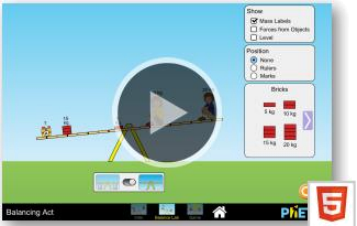
9. Explore the Balancing Act Lab. As you explore, think about the factors that determine whether
or not beams are balanced (kept from rotating). Think of the equation for torque to help you
answer this. List these factors below:
______________________________________________________________________________
10. Is there more than one way to get two objects with identical masses to balance? How? Provide an example.
______________________________________________________________________________
11. Let's attempt to simulate Arnold's feat of strength by setting up a simulation as shown below. Be sure to click on Balance Lab at the bottom of the screen to enable you to select masses and test for equilibrium.
Examine to two diagrams below. You may assume that the "pivot" point (about which the torques are calculated) for the diagram of the left is the man's front (right) foot.
For each diagram, label all of the forces acting and clearly label the pivot. Remember, gravitational forces are always drawn at the object's center of mass location.
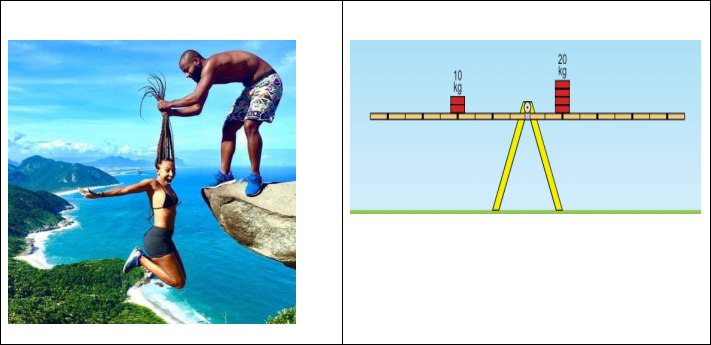
12. Compare the two diagrams above. On the simulation what represents
a. the man?
b. the woman?
c. the front foot of the man?
d. the man's arms?
13. Back to the simulation: Click on the Ruler on the right-hand side. Remove the 10kg mass and replace it with a 5kg mass. What must change in order for the two sides to balance? Justify your answer using the torque equation.
______________________________________________________________________________
______________________________________________________________________________
14. Replace the 5kg with the 10kg mass. Move the 20kg mass one step forward. What must change
in order for the two sides to balance? Justify your answer using the torque equation.
![]()
![]() ______________________________________________________________________________
______________________________________________________________________________
15. Describe the ideal position and "stance" that would enable the man to hold the woman with the least amount of effort (force). Be sure to reference how his center of mass location can be moved. Where should it be ideally? How should he arrange his arms? Again, make references to torque.
______________________________________________________________________________
______________________________________________________________________________
Part 2: Mastery
Find an appropriate point in the clip to analyze. Make sure it is a time when Arnold is dangling the man with one arm only.
Create a screen shot of this event and use it to make estimates as to the location of Arnold's center of mass, along with any other appropriate distances (refer to questions 11 and 12 in Core above).
Use the diagram below for Arnold's basic "dimensions:
Note: Arnold's actual mass is 235lb.
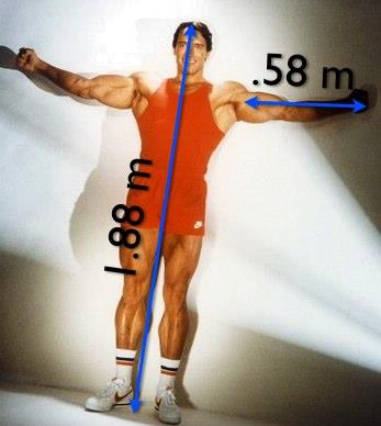
1. Copy and paste your screenshot into the window below and label all forces, the pivot location, and any relevant distances. You may need to play with the contrast to show the image better.
Calculate where Arnold’s centre of mass should be (assuming his mass is 235 lbs):
2. Using your fully labeled diagram above, calculate the location (with respect to the pivot point) of Arnold's center of mass, COM, to enable him to perform this feat. Assume his mass is 235lb
|
for this part while the mass of the dangling man is 150lbs. Arnold's center of mass location - show all steps
COMcalc : behind/front of Arnold's foot (circle) |
![]()
3. Go back to your original screenshot in question 1 above and label the location of this center of
mass, COMcalc. Be sure to utilize the same length scale to accurately label this point. Does your calculated COM location matchup with the position Arnold has placed himself in? Comment on any “suspicious” effects.
|
|
|
|
Calculate what Arnold’smass should be (assuming he had no assistance to pull this off and his COM is where we find it in the video)
4. Using your fully labeled diagram in question 1, calculate what Arnold's mass would need to be to enable him to perform this feat. For this part you will have to measure where his center of
mass APPEARS to be using the appropriate scale. Again, you may assume that the dangling
|
man has a mass of 150 lbs. Arnold's mass (based of the screenshot's COM location) - show all steps
Mass: kg = lb |
5. Summarize these two calculation above. Did Arnold actually hold this "bad guy" up at arm's length as depicted? How do you know? Identify two reasons why or why not this was true or false.
|
|
|
|
Part 3: Ace
Imagine you are a stunt director on the set of this movie and you are required to set this scene up again and make it as realistic as possible. The goal is to emphasize Arnold's immense strength.
1. Describe how you could do this with one, thin, strong cable. The solution should be as
inexpensive as possible. No additional apparatus should be required (cranes etc). You can fasten the cable to things that already exist. Discuss how you would do this with a diagram below. Explain,using torques and equilibrium principles, why this would work effectively.
|
Diagram show how cable is used and attached: |
|
Explain why this works: |
|
|
|
|
|
|
|
|
![]() The director is not happy. He thinks the cables show. You must find another way for Arnold to be able to hold this man at arm's length without rotating forward. Come up with one more
The director is not happy. He thinks the cables show. You must find another way for Arnold to be able to hold this man at arm's length without rotating forward. Come up with one more
solution that does not involve cables. Be creative!
|
Diagram showing "cable free solution": |
|
Explain why this works: |
|
|
|
|
|
|
|
|


